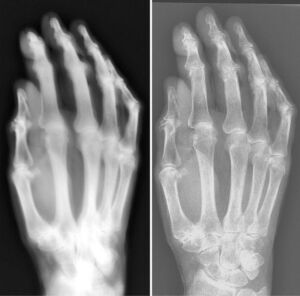by
Brendon Nafziger, DOTmed News Associate Editor | March 17, 2011

The blurry image
on the left was
taken with the
115-year-old
device. (Courtesy RSNA)
1896 was quite a year. Charles Dow printed the first edition of the Dow Jones industrial average. The first modern Olympic Games were held in Athens, Greece. And the first public demonstration of an X-ray machine, by H.L. Smith, took place on January 18, less than a month after Wilhelm Roentgen reported his discovery of X-rays, on Dec. 28, 1895.
But you wouldn't want any part of your body anywhere near that device. Researchers in the Netherlands have dug up a mothballed machine from the time and found out the estimated skin dose needed to image the hand was 1,500 times greater than the dose delivered by current equipment.
"To my knowledge, nobody had ever done systematic measurements on this equipment, since by the time one had the tools, these systems had been replaced by more sophisticated ones," said lead author Gerrit J. Kemerink, from Maastricht University Medical Center in the Netherlands, in a statement.



Ad Statistics
Times Displayed: 79227
Times Visited: 2801 Ampronix, a Top Master Distributor for Sony Medical, provides Sales, Service & Exchanges for Sony Surgical Displays, Printers, & More. Rely on Us for Expert Support Tailored to Your Needs. Email info@ampronix.com or Call 949-273-8000 for Premier Pricing.
In their paper published online this week and in the May edition of Radiology, the researchers report that a modern X-ray device delivers an estimated skin dose of about 0.05 mGy versus nearly 74 mGy for the antique. Plus, new equipment has an exposure time of only 21 milliseconds. But the old machine's exposure time compares to the length of a feature film, at an hour and a half.
The researchers said the images taken by the 115-year-old machine were "surprisingly" good, if a little blurred, when they scanned the hand of a cadaver donated to the hospital (the doses were too high to try on living volunteers).
The device was powered by a new car battery but still retained the old Crookes tube. It was originally rescued to feature in a television documentary about the region's health care history. Dr. Jos M.A. van Engelshoven, the former head of radiology at the medical center, found the equipment moldering in a Maastricht warehouse.
Kemerink said that the high doses delivered by older machines (though not the one tested) were an occupational hazard for radiology pioneers, who could suffer burns, hair loss and eye problems. Sometimes, the damage to hands was so bad it could lead to "amputations or other surgery," he said.
Radiology department might be safer than your home
But the danger from those devices is at least partly in the past. In fact, people wishing to limit their radiation exposure might want to spend more time in a radiology department than in their homes, according to a counterintuitive Dutch study published in the journal Insight into Imaging last month and also written by Kemerink.

